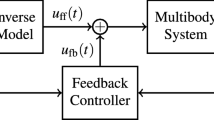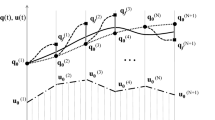Abstract
This work aims to develop a methodology to stabilize the internal dynamics motion considering the second time-derivative trajectory of the system output. For such a purpose, a partitionnement of the generalized coordinates explicit the output and the unobserved coordinates. In sequence, the equation of motion is algebraically modified resulting in a nonlinear differential equation, where states are the unobserved coordinates, and the input represent the second time-derivative of the output related to the original system. A dynamic programming and a collocation method are used to formulate the optimisation problems based on the optimal control theory. The internal dynamics is analyzed; the related optimal feedback control and feedforward control are designed using different methods. The algorithm will search for optimal trajectories of the internal dynamics that stabilizes the system in a constrained motion. The methodology is illustrated in simulation mode considering semi-passive, soft and flexible manipulators in 2D and a rotary inverted pendulum in 3D.












Similar content being viewed by others
References
Bencsik L, Kovács LL, Zelei A (2017) Stabilization of internal dynamics of underactuated systems by periodic servo-constraints. Int J Struct Stab Dyn 17(05):1740004 https://doi.org/10.1142/S0219455417400041
Bencsik L (2018) The importance and effective analysis of the internal dynamics in flexible systems. IFAC-PapersOnLine 51(22):424–428 https://doi.org/10.1016/j.ifacol.2018.11.597
Rigatos G, Siano P, Abbaszadeh M, Ademi S, Melkikh A (2018) Nonlinear h-infinity control for underactuated systems: the furuta pendulum example. Int J Dyn Control 6:835–847
Blajer W, Seifried R, Kołodziejczyk K (2015) Servo-constraint realization for underactuated mechanical systems. Arch Appl Mech 85:1191–1207
Garriga-Casanovas A, Collison I, Rodriguez y Baena F (2018) Toward a common framework for the design of soft robotic manipulators with fluidic actuation. Soft Rob 5(5):622–649
Franco E (2022) Energy shaping control of hydraulic soft continuum planar manipulators. IEEE Control Syst Lett 6:1748–1753
Belke CH, Paik J (2017) Mori: a modular origami robot. IEEE/ASME Trans Mechatron 22(5):2153–2164
Book WJ, Maizza-Neto O, Whitney DE (1975) Feedback control of two beam, two joint systems with distributed flexibility. J Dyn Syst Meas Contr 97(4):424–431
Korayem MH, Nohooji HR (2008) Trajectory optimization of flexible mobile manipulators using open-loop optimal control method. LNCS Lecture Notes Comput Sci 5314:54–63
Fenili A, Balthazar JM (2011) The rigid-flexible nonlinear robotic manipulator: modeling and control. Commun Nonlinear Sci Numer Simul 16(5):2332–2341
Cristofaro A, De Luca A, Lanari L (2021) Linear-quadratic optimal boundary control of a one-link flexible arm. IEEE Control Syst Lett 5(3):833–838
Yadav KP, Kumar RP (2022) Biped dynamic walker modeling and control for underactuated gait cycle. Int J Dyn Control 10:1138–1147
Pellicano MFF (1997) Nonlinear dynamics of a beam on elastic foundation. Nonlinear Dyn 14:335–355
Mitsi S, Natsiavas S, Tsiafis I (1998) Dynamics of nonlinear oscillators under simultaneous internal and external resonances. Nonlinear Dyn 16:23–39
Suzumori K, Miyagawa T, Kimura M, Hasegawa Y (1999) Micro inspection robot for 1-in pipes. IEEE/ASME Trans Mechatron 4(3):286–292
Gerboni G, Ranzani T, Diodato A, Ciuti G, Cianchetti M, Menciassi A (2015) Modular soft mechatronic manipulator for minimally invasive surgery (MIS): overall architecture and development of a fully integrated soft module. Meccanica 50(11):2865–2878
Franco E, Garriga-Casanovas A, Tang J, RodriguezyBaena F, Astolfi A (2022) Adaptive energy shaping control of a class of nonlinear soft continuum manipulators. IEEE ASME Trans Mechatron 27(1):280–291. https://doi.org/10.1109/TMECH.2021.3063121
Toglia C, Sabatini M, Gasbarri P, Palmerini GB (2011) Optimal target grasping of a flexible space manipulator for a class of objectives. Acta Astronaut 68(7):1031–1041
Kumar BP (2019) andPratiher: modal characterization with nonlinear behaviors of a two-link flexible manipulator. Arch Appl Mech 89:1201–1220
Géradin M, Cardona A (2001) Flexible multibody dynamics: a finite element approach. Wiley, New York, p 327
Bastos G (2021) A stable reentry trajectory for flexible manipulators. Int J Control 94(5):1297–1308
Bastos G (2022) A non-inherent parametric estimation for dynamical equivalence of flexible manipulators. Optim Control Appl Methods 43(3):825–841
Blajer W, Dziewiecki K, Kołodziejczyk K, Mazur Z (2011) Inverse dynamics of underactuated mechanical systems: a simple case study and experimental verification. Commun Nonlinear Sci Numer Simul 16(5):2265–2272
Seifried R (2014) Dynamics of underactuated multibody system. Springer, Berlin
Brüls O, Bastos G, Seifried R (2014) A stable inversion method for constrained feedforward control of flexible multibody systems. J Comput Nonlinear Dyn 9:011014
Bastos G, Brüls O (2020) Analysis of open-loop control design and parallel computation for underactuated manipulators. Acta Mech 231:2439–2456
Bastos G, Seifried R, Brüls O (2017) Analysis of stable model inversion methods for constrained underactuated mechanical systems. Mech Mach Theory 111:99–117
Bastos G Franco E (2023) Dynamic tube model predictive control for a class of soft manipulators with fluidic actuation. Int J Robust Nonlinear Control 1–20. https://doi.org/10.1002/rnc.6598
Allgower F, Findeisen R, Nagy ZK (2004) Nonlinear model predictive control: from theory to application. J Chin Inst Chem Eng 35(3):299–315
Bellman R (1957) Dynamic programming. Princeton University Press, Princeton
Betts JT (2010) Pratical methods for optimal control and estimation using nonlinear programming, 2nd edn. Society for Industrial and Applied Mathematics, USA, p 434
Bastos G, Franco E (2021) Energy shaping dynamic tube-MPC for underactuated mechanical systems. Nonlinear Dyn 106:359–380
Diehl M, Gros S (2018) Numerical optimal control. Syscop, Freiburg, Germany. http://www.syscop.de/numericaloptimalcontrol
Chung J, Hulbert GM (1993) A time integration algorithm for structural dynamics with improved numerical dissipation: the generalized-\(\alpha \) method. ASME J Appl Mech 60:371–375
Arnold M, Brüls O (2007) Convergence of the generalized-\(\alpha \) scheme for constrained mechanical systems. Multibody Syst Dyn 18(2):185–202
Newmark NM (1959) A method of computation for structural dynamics. J Eng Mech 85:67–94
Shi B, Peng H, Wang X, Zhong W (2022) A symplectic direct method for motion-driven optimal control of mechanical systems. Commun Nonlinear Sci Numer Simul 111:106501
Fisette P, Samin JC, Vaneghem B (1996) Simulation of flexible multibody systems: coordinate partitioning method in an implicit integration scheme. In: Second ECCOMAS conference on numerical methods in engineering
Godage IS, Wirz R, Walker ID, Webster RJ (2015) Accurate and efficient dynamics for variable-length continuum arms: a center of gravity approach. Soft Rob 2(3):96–106
Mattioni A, Wu Y, Ramirez H, Le Gorrec Y, Macchelli A (2020) Modelling and control of an IPMC actuated flexible structure: a lumped port Hamiltonian approach. Control Eng Pract 101:104498
Franco E, Garriga-Casanovas A (2021) Energy-shaping control of soft continuum manipulators with in-plane disturbances. Int J Rob Res 40(1):236–255
Yu Y-Q, Howell LL, Lusk C, Yue Y, He M-G (2005) Dynamic modeling of compliant mechanisms based on the pseudo-rigid-body model. J Mech Des 127(4):760. https://doi.org/10.1115/1.1900750
Gupta N, Dewan L (2019) Modeling and simulation of rotary–rotary planer inverted pendulum. J Phys Conf Ser 1240(1):012089
Bastos GJ, Brüls O (2010) Trajectory optimization of flexible robots using an optimal control approach. In: Proceedings of the 1st joint international conference on multibody system dynamics
Funding
The author declare that he has no special funding related to this work.
Author information
Authors and Affiliations
Contributions
I am single author of this work.
Corresponding author
Ethics declarations
Conflict of interest
The author declare that he has no conflict of interest to this work.
Supplementary Information
Below is the link to the electronic supplementary material.
Rights and permissions
Springer Nature or its licensor (e.g. a society or other partner) holds exclusive rights to this article under a publishing agreement with the author(s) or other rightsholder(s); author self-archiving of the accepted manuscript version of this article is solely governed by the terms of such publishing agreement and applicable law.
About this article
Cite this article
Bastos, G. Analysis of internal dynamics in trajectory tracking problems. Int. J. Dynam. Control 11, 2870–2885 (2023). https://doi.org/10.1007/s40435-023-01161-1
Received:
Revised:
Accepted:
Published:
Issue Date:
DOI: https://doi.org/10.1007/s40435-023-01161-1




